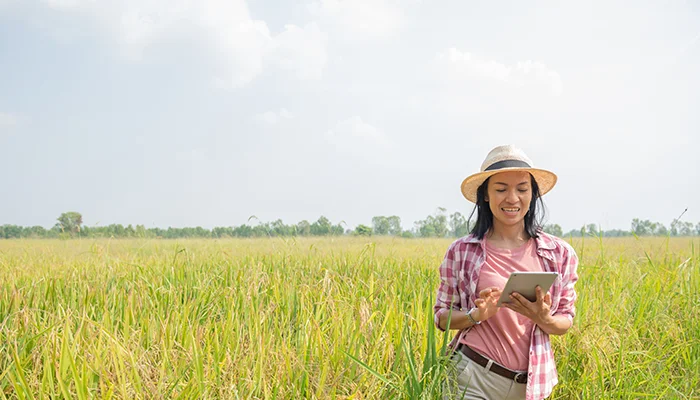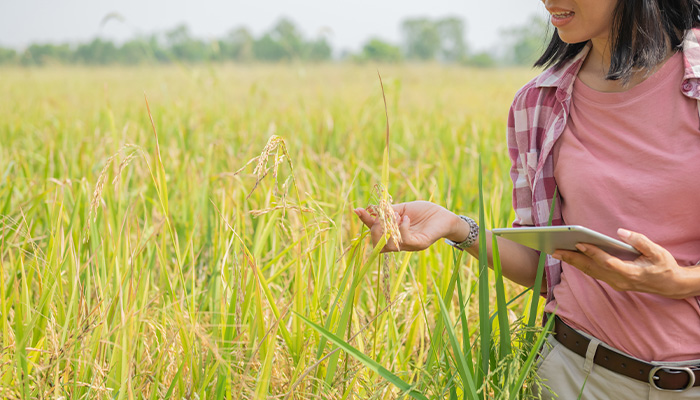How Much Does it Cost to Develop a Smart Farming App?

MAY, 14, 2024 15:20 PM
How Much Does it Cost to Develop a Smart Farming App?
In recent years, the agriculture industry has witnessed a significant transformation through the integration of technology. Smart farming, also known as precision agriculture, has emerged as a revolutionary approach to optimizing agricultural operations using advanced technologies like IoT, AI, and data analytics. Central to this transformation are smart farming apps, which empower farmers to monitor, manage, and optimize various aspects of their operations using their smartphones or tablets.
However, for entrepreneurs and businesses looking to venture into the development of a smart farming app, one of the crucial considerations is the cost involved. Understanding the factors influencing the cost can help in budgeting and planning effectively. So, let's delve into the key aspects that contribute to the cost of developing a smart farming app.
- Features and Functionality: Real-time monitoring of weather conditions involves integrating with weather APIs or deploying weather stations to gather data on temperature, humidity, precipitation, and wind speed. Soil health analysis may require soil sensors or sampling tools to measure pH levels, moisture content, and nutrient levels. Crop management features encompass a range of functionalities such as crop planning, scheduling, and task management, often tailored to specific crop types and growing seasons. Pest detection can utilize image recognition algorithms trained on datasets of common pests and diseases to identify symptoms and recommend treatment options. Advanced Functionalities: Predictive analytics relies on historical data, machine learning models, and algorithms to forecast crop yields, disease outbreaks, and market demand. Integration with external data sources, such as market prices, satellite imagery, and government databases, enhances the accuracy and reliability of predictions. Drone integration for aerial monitoring involves hardware considerations such as drone selection, payload capacity, and flight planning software, as well as regulatory compliance for airspace regulations and safety protocols. Automated machinery control requires interfacing with agricultural equipment via IoT protocols like MQTT or CoAP, enabling remote operation, diagnostics, and optimization of machinery performance based on real-time data from the field.
- Platform: iOS, Android, or Both Choosing between iOS and Android platforms depends on factors such as target audience demographics, market share, and development resources. Developing for both platforms simultaneously requires expertise in cross-platform development frameworks like Xamarin or React Native, as well as additional testing efforts to ensure compatibility and performance across different devices and operating system versions.
- User Interface: Designing an intuitive and visually appealing interface involves conducting user research, creating wireframes, and prototyping user interactions. Accessibility considerations such as font sizes, color contrast, and screen reader compatibility are essential for accommodating users with disabilities or low vision. Customizable dashboards allow farmers to personalize their experience and prioritize relevant information based on their preferences and workflow. b. User Experience: Usability testing involves recruiting participants from the target user demographic to perform tasks and provide feedback on the app's usability, navigation, and functionality. Iterative design iterations based on user feedback and analytics data ensure continuous improvement and refinement of the user experience over time.
- Integration with sensors and IoT devices a. Sensor Integration: Smart farming apps may interface with a variety of sensors and IoT devices, including soil moisture sensors, temperature sensors, GPS trackers, and drone-mounted cameras. Standardizing communication protocols such as MQTT or OPC UA facilitates interoperability and data exchange between different devices and platforms. Implementing edge computing solutions enables data processing and analysis at the device level, reducing latency and bandwidth requirements for transmitting data to the cloud. b. IoT Device Connectivity: Secure device provisioning and authentication mechanisms prevent unauthorized access to IoT devices and protect against cyber threats such as man-in-the-middle attacks or device tampering. Implementing role-based access control (RBAC) ensures that only authorized users can access sensitive data or perform administrative tasks such as device configuration and management.
- Data Analytics and AI: Data Processing: Scalable data storage solutions such as cloud-based databases or distributed file systems accommodate the volume and velocity of data generated by sensors and IoT devices. Implementing data pipelines and ETL (extract, transform, load) processes streamlines data ingestion, cleansing, and transformation workflows, preparing raw data for analysis and visualization. b. Machine learning models: Developing machine learning models involves selecting appropriate algorithms, feature engineering, model training, and evaluation using techniques such as cross-validation and hyperparameter tuning. Transfer learning techniques leverage pre-trained models and datasets to accelerate model development and reduce data annotation costs. Continuous model monitoring and retraining ensure that machine learning models remain accurate and relevant as new data becomes available.
- Security and Compliance:. Data Encryption: Encrypting data at rest and in transit using cryptographic algorithms such as AES (Advanced Encryption Standard) or RSA (Rivest-Shamir-Adleman) protects sensitive information from unauthorized access or interception by malicious actors. Implementing secure key management practices and encryption protocols ensures data confidentiality and integrity across the entire data lifecycle. b. Regulatory Compliance: Compliance with data protection regulations such as GDPR, CCPA (California Consumer Privacy Act), and HIPAA requires implementing privacy-by-design principles, conducting privacy impact assessments, and obtaining user consent for data collection and processing activities. Maintaining audit trails and data access logs facilitates compliance reporting and incident response in the event of a security breach or data leak.
- Maintenance and Support:Bug Fixes and Updates: Establishing a robust bug tracking and issue management system enables developers to prioritize and address software defects reported by users or identified through automated testing. Continuous integration and deployment pipelines automate the process of releasing software updates and patches, minimizing downtime and disruption to users. b. Feature Enhancements: Soliciting user feedback through surveys, focus groups, and customer support channels informs the prioritization of new features and functionality on the product roadmap. Agile development methodologies such as Scrum or Kanban facilitate iterative development cycles, allowing for rapid prototyping and experimentation with new ideas and concepts.
Now, let's quantify these costs based on the services of a mobile app development company in Singapore, known for its expertise in developing cutting-edge solutions.
- Basic Features Development:
- Weather Monitoring: Developing a feature that provides real-time weather updates may involve integrating with third-party weather APIs or deploying weather sensors. Costs can vary depending on the complexity of the integration and the frequency of data updates required.
- Soil Health Analysis: Implementing soil health analysis features may require the integration of soil sensors or laboratory testing services. Costs may include sensor procurement, calibration, and data processing fees.
- Crop Management: Building features for crop planning, scheduling, and task management involves backend development to manage data storage and synchronization across devices. Costs may also include user interface design and frontend development for intuitive user interaction.
- Pest Detection: Integrating image recognition algorithms or sensor data analysis for pest detection may require expertise in computer vision and machine learning. Costs may include data labeling, model training, and algorithm optimization.
- Platform:
- iOS, Android, or Both: Developing for a single platform allows for focused development efforts and may be more cost-effective initially. However, targeting both the iOS and Android platforms ensures broader market coverage and accessibility for farmers using different devices.
- Cross-Platform Development: Utilizing cross-platform development frameworks like Xamarin or React Native can streamline development efforts and reduce costs compared to native development for each platform. However, additional testing and optimization may be required to ensure compatibility and performance across different devices and operating systems.
- UI/UX Design :
- User Interface Design: Investing in high-quality UI/UX design is essential for creating an intuitive and visually appealing user experience. Costs may include user research, wireframing, prototyping, and iterative design iterations based on user feedback.
- User Experience Optimization: Conducting usability testing and A/B testing to evaluate user interactions and iterate on design improvements can enhance user satisfaction and engagement. Costs may also include accessibility testing to ensure compliance with accessibility standards and guidelines.
- Integration with Sensors and IoT Devices:
- Sensor Integration: Integrating with various sensors, such as weather stations, soil moisture sensors, and crop health monitors, requires expertise in IoT protocols and data communication. Costs may include sensor procurement, hardware installation, and software development for data processing and analysis.
- IoT Device Connectivity: Implementing secure communication protocols and authentication mechanisms for IoT device connectivity ensures data integrity and protection against cyber threats. Costs may include developing custom APIs and middleware for device management and data exchange.
- Data analytics and AI:
- Data Processing: Processing and analyzing large volumes of agricultural data from sensors and IoT devices requires scalable infrastructure and efficient algorithms. Costs may include cloud computing resources, data storage fees, and software development for data processing pipelines.
- Machine Learning Models: Developing and training machine learning models for predictive analytics and crop classification may require expertise in data science and algorithm development. Costs may include data annotation, model training, and cloud-based machine learning services.
- Security and Compliance:
- Data Encryption: Implementing end-to-end encryption and SSL/TLS protocols for data transmission ensures data confidentiality and protection against eavesdropping attacks. Costs may include cryptographic libraries, SSL certificates, and security audits.
- Regulatory Compliance: Ensuring compliance with data protection regulations such asGDPR, CCPA, and industry-specific standards requires legal expertise and documentation of data handling practices. Costs may include privacy impact assessments, compliance audits, and regulatory consulting services.
- Maintenance and Support:
- Bug Fixes and Updates: Establishing a comprehensive bug tracking and issue management system enables developers to address software defects and release timely updates. Costs may include developer hours for bug fixing, testing, and deployment.
- Feature Enhancements: Incorporating user feedback and market trends into the product roadmap ensures ongoing innovation and relevance. Costs may include software development for new features, user interface redesign, and usability testing.
Conclusion

In conclusion, the cost of developing a smart farming app depends on various factors such as the complexity of features, platform requirements, design considerations, integration with sensors and IoT devices, data analytics and AI capabilities, security and compliance measures, and ongoing maintenance and support. By carefully assessing these factors and allocating resources effectively, businesses can deliver a robust and user-friendly solution that meets the needs of farmers and contributes to the advancement of the agriculture industry.
Strategy
Design
Blockchain Solution
Development
Launching
Testing
Maintenance
Contact US!
India

Plot 378-379, Udyog Vihar Phase 4 Rd, near nokia building, Electronic City, Phase IV, Sector 19, Gurugram, Haryana 122015
Copyright © 2025 PerfectionGeeks Technologies | All Rights Reserved | Policy
Strategy
Design
Blockchain Solution
Development
Contact US!
India 
Plot 378-379, Udyog Vihar Phase 4 Rd, near nokia building, Electronic City, Phase IV, Sector 19, Gurugram, Haryana 122015
USA 
1968 S. Coast Hwy, Laguna Beach, CA 92651, United States
Copyright © 2025 PerfectionGeeks Technologies | All Rights Reserved | Policy




